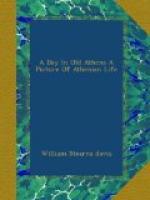[*]In Gulick ("Life of the Ancient Greeks,” pp. 304-310) there is a valuable list of Attic festivals. The Athenians had over thirty important religious festivals, several of them, e.g., the Thesmorphoria (celebrated by the women in honor of Demeter), extending over a number of days.
[+][Note from Brett: A “Scotch Sunday” refers to the practice of the Sabbath day in Scotland. During the Sabbath day (at the time of the author of this work) in Scotland no activity goes on except for Church. There is no travel, no telecommunication, no cooking, not allowed to read the newspaper, etc. A “Scotch Sunday” therefore, represents a day of religious austerity.]
[&]It is needless to point out that to the Greeks, as to many other ancient peoples,—for example, the Hebrews,—dancing often had a religious significance and might be a regular part of the worship of the gods.
199. The Eleusinia.—Our first festival is the Eleusinia, the festival of the Eleusinian mysteries. It is September, the “19th of Boedromion,” the Athenians will say. Four days have been spent by the “initiates” and the “candidates” in symbolic sacrifices and purifications.[*] On one of these days the arch priest, the “Hierophant,” has preached a manner of sermon at the Painted Porch in the Agora setting forth the awfulness and spiritual efficacy of these Mysteries, sacred to Demeter the Earth Mother, to her daughter Persephone, and also to the young Iacchus, one of the many incarnations of Dionysus, and who is always associated at Elusis with the divine “Mother and Daughter.” The great cry has gone forth to the Initiates—“To the Sea, ye Myste!” and the whole vast multitude has gone down to bathe in the purifying brine.
[*]Not all Athenians were among the “initiated,” but it does not seem to have been hard to be admitted to the oaths and examination which gave one participation in the mysteries. About all a candidate had to prove was blameless character. Women could be initiated as well as men.
Now on this fifth day comes the sacred procession from Athens across the mountain pass to Eleusis. The participates, by thousands, of both sexes and of all ages, are drawn up in the Agora ere starting. The Hierophant, the “Torchbearer,” the “Sacred Herald,” and the other priests wear long flowing raiment and high mitres like Orientals. They also, as well as the company, wear myrtle and ivy chaplets and bear ears of corn and reapers’ sickles. The holy image of Iacchus is borne in a car, the high priests marching beside it; and forth with pealing shout and chant they go,—down the Ceramicus, through the Dipylon gate, and over the hill to Eleusis, twelve miles away.
200. The Holy Procession to Eleusis.—Very sacred is the procession, but not silent and reverential. It is an hour when the untamed animal spirits of the Greeks, who after all are a young race and who are gripped fast by natural instinct, seem uncurbed. Loud rings the “orgiastic” cry, “Iacche! Iacche! evoe!”




